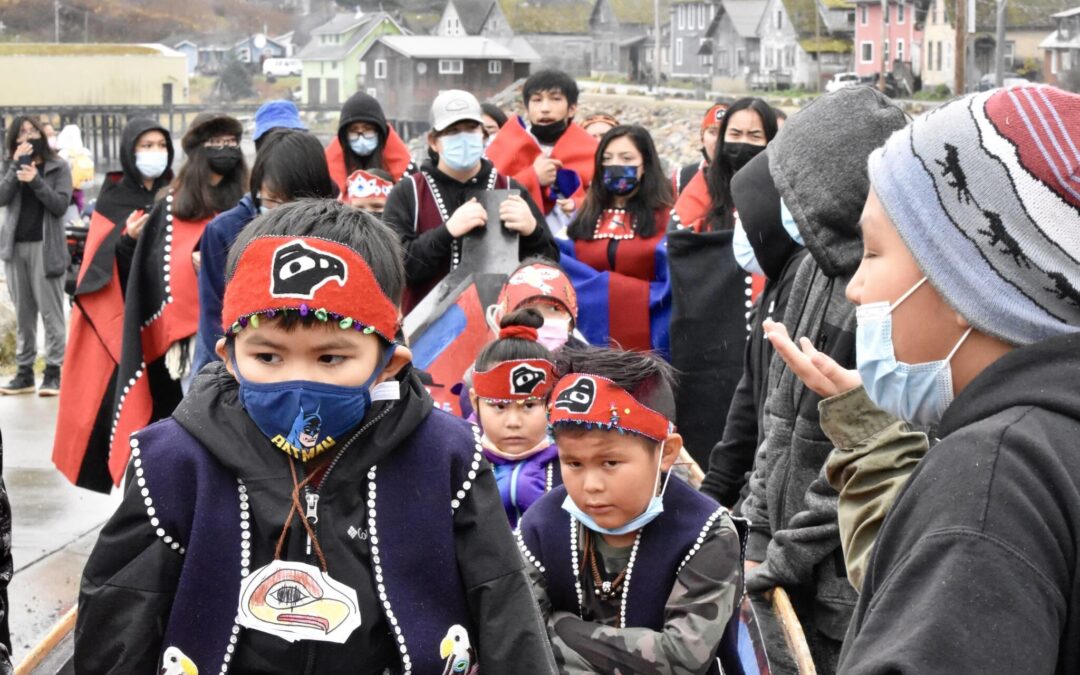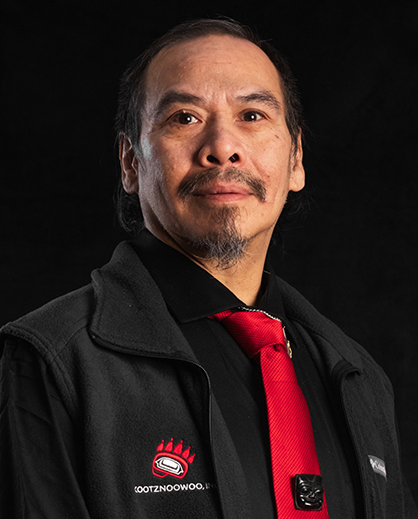Article Reprinted courtesy of the Juneau Empire. Originally published Oct. 27, 2021
More than a century after the U.S. Navy opened fire on the village of Angoon, its residents take comfort that despite the violence, the village remains.
“It’s a happy anniversary even if it’s tragic,” said Chenara Johnson, a Tlingit language teacher with the Chatham School District. “(Our ancestors) kept our home so we can still live here. If it weren’t for the people that stood their ground we wouldn’t be here today.”
In 1882, the U.S. Navy ship Corwin shelled and burned Angoon following a confrontation with a private trading company, according to the Navy’s Naval History and Heritage Command. A series of letters reporting the event to federal officials are held in the NHHC’s collection and state the shelling was ordered in response to Alaska Natives taking hostages following a death of a local in a whaling accident.
“One of the bombs used in whaling accidentally exploded, killing one of the native crew, who happened to hold the rank of medicine man or shaman among the tribe,” a letter from the Corwin’s commander, M.A. Healy, said. “For this man the natives demanded two hundred blankets, at the same time seizing the whaling-boats with their equipments, and holding two of the white men prisoners until the amount should be paid.”
The company contacted the U.S. Navy, which dispatched ships with marines to Angoon, the letters say, and the hostages were immediately released when the ships arrived.
“In addition to this, as a punishment and as a guarantee for future good behavior, Captain Merriman demanded twice the number of blankets demanded by the Indians, and threatened, in case of refusal, to destroy their canoes and villages,” another of Healy’s letters stated.
That the Navy demanded more blankets than Angoon was able to provide is something Johnson tries to stress to her own children, she said.
“One thing I try to stress is we did have that traumatic event happen here but all of our houses are still standing. Our people are still here. Becoming one as a community strengthens us.”
This year’s anniversary, the 139th, featured a procession down Angoon’s waterfront, showcasing a “dugout” canoe, the same kind that were specifically targeted by the Corwin. Refusing to pay the amount and remaining defiant, their canoes, to the number of forty, were taken and destroyed, after having selected those which belonged to the Indians who had remained friendly to the white men,” Healy’s letter said. “After shelling the village the marines were landed under cover of the guns, and they, setting fire to the houses, destroyed the entire village, with the exception of the friendly Indians.”
Bringing back the dugout
On Tuesday, a canoe made by Tlingit master carver Wayne Price, surrounded by students of all ages wearing regalia, was wheeled down the waterfront to the sound of Tlingit chants and songs. At the end of the procession, the group of about 50, sang more songs before the students and teachers returned to their classrooms.
Price has been working in Angoon teaching traditional canoe making. The canoe in the procession was one carved earlier by Price, but in the parking lot beside Angoon High School, a massive log of red cedar is being shaped into a new canoe.
On Tuesday, Price’s students from the University of Alaska Southeast were chipping away at the log while students from the high school were gathering wood for a bonfire.
Part of the process for building a dugout canoe involves using superheated rocks to steam open the inside of the boat. Price said he’s typically used lava rocks for that, which are uncommon around Angoon. Price said he’s been trying to figure out what kind of rocks would have been used locally by the people of Angoon.
On Monday, Price and some high school students went out to the local beaches to collect large rocks that might work. Tuesday morning the students lit a bonfire on the beach with the rocks at its base. Once hot enough they’ll be dumped into a drum of seawater to see if they’ll hold up under the steaming process.
Price said that as he and the students were wheeling the dugout canoe down to the waterfront, he thought about what that loss must have felt like.
“I thought, what if they smashed my dugout right now? How would I feel,” Price said. “I can’t fathom that atrocity, the people of Angoon deserve an apology.”
A history of waiting
The U.S. government has never formally apologized for the shelling of Angoon, but in February 2020 Air Force Lt. Gen. Tom Bussiere, Commander of Alaskan Command, met with Alaska Native leaders to discuss the history of U.S. military violence in Southeast Alaska.
Angoon was not the only Alaska Native village in Southeast Alaska shelled by the military. In 1869, the U.S. military destroyed villages near the present-day cities of Wrangell and Kake, according to the Sealaska Heritage Institute, which organized the 2020 meeting with Bussiere.
Standing on the waterfront next to the dugout, waiting for the procession to begin, Price commented to one of his students, “this is where is all happened, and we’re still here.”
Price said the canoe being carved beside Angoon High School will be the first such canoe to be crafted in the village since the bombardment.
“When the Navy came here, we were all under the same flag,” Price said. “There’s been no apology, what does that say to so many things?”
Carving a new future
Two of the UAS students helping Price to carve the dugout were members of a carving club at the university and said they wanted to be Tlingit language teachers.
“We’re all trying to become Tlingit language teachers in our own domain,” said Ḵuchain Bowers, as he hewed away at the 30-foot log. “We all share the vision of teaching the language through the dugout, through getting the youth back on the water.”
Sophomore Kyle Johnson, 15, said when he thinks about the bombardment he thinks about what his ancestors had to go through at his age.
“It can be tough, you know, knowing the struggles our ancestors had to go through at that age,” he said. “Our culture just shows how strong we are after the bombardment.”
Price said he was thankful his job allowed him to travel to places like Angoon and teach young people about their culture.
“Dugouts we’re part of our history for thousands of years, they shouldn’t just be passed on into history,” Price said. “There’s a resurgence being created with the work we’re doing, being the healing medicine of dugout canoes.”
Click Here to view the original article “Remembering and rebuilding: Angoon residents commemorate 139 years since bombardment” on the Juneau Empire.



